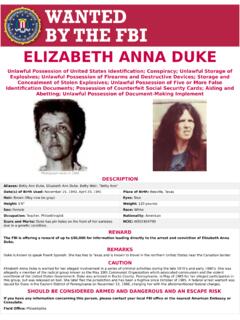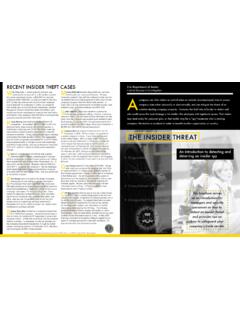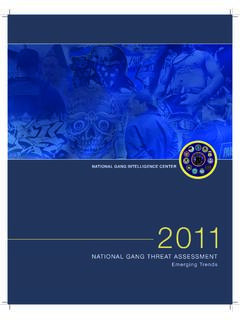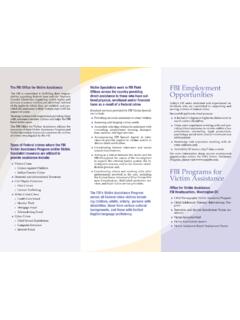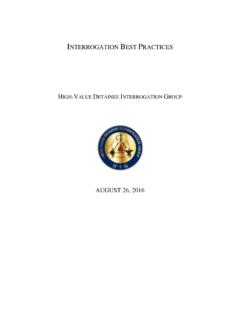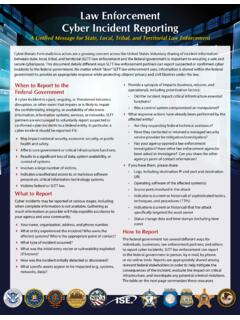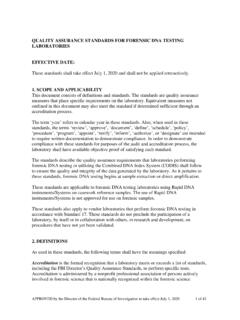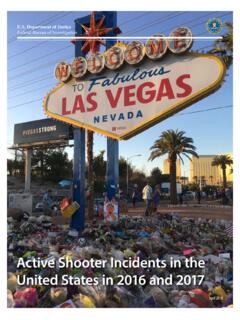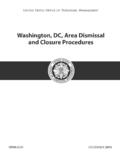Transcription of Federal Bureau of Investigation Department of Homeland …
1 Page 1 of 40 Federal Bureau of Investigation Department of Homeland Security Strategic Intelligence Assessment and Data on Domestic Terrorism Submitted to the Permanent Select Committee on Intelligence, the Committee on Homeland Security, and the Committee of the Judiciary of the United States House of Representatives, and the Select Committee on Intelligence, the Committee on Homeland Security and Governmental Affairs, and the Committee of the Judiciary of the United States Senate May 2021 Page 2 of 40 Table of Contents I. Overview of Reporting Requirement .. 2 II. Executive Summary .. 2 III. 2 IV. Strategic Intelligence Assessment .. 5 V. Discussion and Comparison of Investigative Activities .. 9 VI. FBI Data on Domestic Terrorism .. 19 VII. Recommendations .. 27 Appendix .. 29 I. Overview of Reporting Requirement The National Defense Authorization Act for Fiscal Year 2020 (the Act) requires the Director of the Federal Bureau of Investigation (FBI) and the Secretary of Homeland Security, in consultation with the Director of National Intelligence (DNI), to jointly produce a report containing a strategic intelligence assessment and data on domestic terrorism (DT).
2 1 The Act requires the report to contain a strategic intelligence assessment, a discussion of activities, certain data on DT matters, and recommendations. II. Executive Summary Preventing terrorist attacks remains a top priority for both the FBI and the Department of Homeland Security (DHS). The threat posed by international and domestic threat actors has evolved significantly since 9/11. The greatest terrorism threat to the Homeland we face today is posed by lone offenders,2 often radicalized online, who look to attack soft targets with easily accessible weapons. Many of these violent extremists are motivated and inspired by a mix of socio-political goals and personal grievances against their targets. With this report, we are providing our strategic intelligence assessments on DT, a detailed discussion of our procedures and methods to address DT threats, as well as data on DT incidents and our investigations. III. Introduction The FBI and DHS are both charged with preventing terrorist attacks in the United States, including those conducted by Domestic Violent Extremists (DVEs).
3 3 This goal drives the FBI s mission to proactively lead law enforcement and domestic intelligence efforts to defeat terrorist attacks against US citizens and US interests through an integrated strategy to detect, penetrate, 1 Public Law 116-92, enacted 20 December 2019. 2 The FBI and DHS defines a lone offender as an individual motivated by one or more violent extremist ideologies who, operating alone, supports or engages in acts of unlawful violence in furtherance of that ideology or ideologies that may involve influence from a larger terrorist organization or a foreign actor. 3 The FBI and DHS define a Domestic Violent Extremist (DVE) as an individual based and operating primarily within the United States or its territories without direction or inspiration from a foreign terrorist group or other foreign power who seeks to further political or social goals wholly or in part through unlawful acts of force or violence.
4 The mere advocacy of political or social positions, political activism, use of strong rhetoric, or generalized philosophic embrace of violent tactics may not constitute extremism, and may be constitutionally protected. Page 3 of 40 disrupt, and dismantle criminal DT plots, and the FBI and DHS missions to provide strategic analysis of the DVE landscape. DT for the FBI s purposes is referenced in US Code at 18 2331(5), and is defined as activities: Involving acts dangerous to human life that are a violation of the criminal laws of the United States or of any State; Appearing to be intended to: o Intimidate or coerce a civilian population; o Influence the policy of government by intimidation or coercion; or o Affect the conduct of a government by mass destruction, assassination or kidnapping; and Occurring primarily within the territorial jurisdiction of the United States. In comparison, international terrorism (IT) for the FBI s purposes is referenced in Code at 18 2331(1), and is defined as activities: Involving violent acts or acts dangerous to human life that are a violation of the criminal laws of the United States or of any State, or that would be a criminal violation if committed with the jurisdiction of the United States or of any State; Appearing to be intended to: o Intimidate or coerce a civilian population; o Influence the policy of government by intimidation or coercion; or o Affect the conduct of a government by mass destruction, assassination or kidnapping.
5 And Occurring primarily outside the territorial jurisdiction of the United States, or transcend national boundaries in terms of the means by which they are accomplished, the persons they appear intended to intimidate or coerce, or the locale in which their perpetrators operate or seek The DHS derives its definition of DT from the Homeland Security Act definition of terrorism, 6 101(18), which is similar to, but not identical, to the 18 2331(5) definition. Under the Homeland Security Act, terrorism: 4 In certain instances, a DVE s conduct may eventually lead to the DVE engaging in international terrorism, as defined in 18 2331(1). Page 4 of 40 Involves an act that: o Is dangerous to human life or potentially destructive of critical infrastructure or key resources; and o Is a violation of the criminal laws of the United States or any State or other subdivision of the United States, and Appears to be intended to: o Intimidate or coerce a civilian population; o Influence the policy of a government by intimidation or coercion; or o Affect the conduct of a government by mass destruction, assassination, or kidnapping.
6 In our discussion of DT threats, we use the words violent extremism to define DT threats because mere advocacy of political or social positions, political activism, use of strong rhetoric, or generalized philosophic embrace of violent tactics may not constitute violent extremism, and may be constitutionally protected. Under FBI policy and Federal law, no investigative activity may be based solely on First Amendment activity, or the apparent or actual race, ethnicity, national origin, religion, gender, sexual orientation, or gender identity of the individual or group. The FBI does not investigate, collect, or maintain information on US persons solely for the purpose of monitoring activities protected by the First Amendment. While the majority of DVEs fall into one threat category, some draw upon or are inspired by ideological themes found in other threat categories, as depicted in the following graphic. Page 5 of 40 IV.
7 Strategic Intelligence Assessment The Act calls for a strategic intelligence assessment of DT in the United States during 2017, 2018, and 2019. Since 2017, while the FBI successfully investigated and disrupted DVE activities, plots, and threats, and the FBI and DHS continued to provide strategic warnings and analysis of the heightened DVE threat, DVE lone offenders acting independently and without direction from specific groups have been the primary actor in DT lethal attacks. The FBI and DHS assessed lone offenders would continue to be the primary actor in these attacks, and would continue to pose significant mitigation challenges due to their capacity for independent radicalization and mobilization and preference for easily accessible weapons. The FBI and DHS assessed multiple factors, including perceptions of or responses to political and social conditions and law Page 6 of 40 enforcement and government overreach, would also almost certainly continue to contribute to DVE radicalization, target selection, and mobilization in violation of Federal , state, and local law and hate crime5 statutes.
8 Strategic Intelligence Assessment for 2017 In 2017, DVEs remained a persistent source of violence, with Racially or Ethnically Motivated Violent Extremists (RMVEs)6 advocating for the superiority of the white race and Anti-Government or Anti-Authority Violent Extremists (AGAAVEs) primarily Anarchist Violent Extremists (AVEs),7 Militia Violent Extremists (MVEs),8 and Sovereign Citizen Violent Extremists (SCVEs)9 presenting the greatest threats of violence. RMVEs were the primary sources of lethal and significant violence, with lone offenders conducting lethal attacks against targets of opportunity, using non-complex tactics and accessible weapons. The FBI and DHS assessed broad drivers of domestic violent extremism, including perceptions of or responses to government activity, and social, political, and economic conditions, continued to feed a consistent level of domestic violent extremism, although trends within individual extremist movements remained dynamic.
9 DVE violence in 2017 consisted primarily of attacks or threatening behavior against accessible targets or individuals, using weapons acquired with relative ease, including firearms and bladed weapons, or unsophisticated tactics such as physical assaults. Law enforcement and racial minorities were the prevalent DVE targets in 2017, with race providing a principal focus for RMVEs espousing the superiority of the white race, and law enforcement and government continuing to represent key targets of interest for AGAAVEs, specifically MVEs and SCVEs. Numerous violent encounters also took place between perceived ideological opponents. 5 A hate crime is a criminal offense that was motivated, in whole or in part, by the offender s bias against a person s actual or perceived race/ethnicity/ancestry, national origin gender, gender identity, religion, disability, or sexual orientation, and was committed against persons, property, or society.
10 6 As defined by the FBI and DHS, racially or ethnically motivated violent extremism encompasses the potentially unlawful use or threat of force or violence in furtherance of ideological agendas derived from bias, often related to race or ethnicity, held by the actor against others or a given population group. RMVEs purport to use both political and religious justifications to support their racially- or ethnically-based ideological objectives and criminal activities. 7 As defined by the FBI and DHS, anarchist violent extremism encompasses the potentially unlawful use or threat of force or violence in furtherance of an anti-government or anti-authority violent extremist ideology that considers capitalism and centralized government to be unnecessary and oppressive. 8 As defined by the FBI and DHS, militia violent extremism encompasses the potentially unlawful use or threat of force or violence in furtherance of an anti-government or anti-authority violent extremist ideology in response to perceived abuses of power by the government, especially in regard to suspected infringements on gun rights; excessive use of force by law enforcement; or bureaucratic incompetence in attending to critical tasks.
